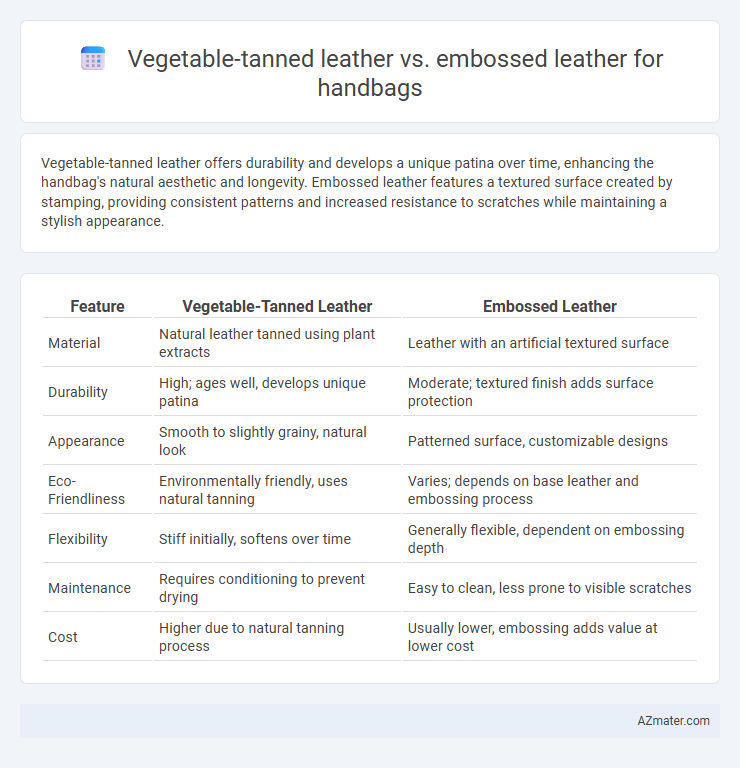Vegetable-tanned leather offers durability and develops a unique patina over time, enhancing the handbag's natural aesthetic and longevity. Embossed leather features a textured surface created by stamping, providing consistent patterns and increased resistance to scratches while maintaining a stylish appearance.
Table of Comparison
| Feature | Vegetable-Tanned Leather | Embossed Leather |
|---|---|---|
| Material | Natural leather tanned using plant extracts | Leather with an artificial textured surface |
| Durability | High; ages well, develops unique patina | Moderate; textured finish adds surface protection |
| Appearance | Smooth to slightly grainy, natural look | Patterned surface, customizable designs |
| Eco-Friendliness | Environmentally friendly, uses natural tanning | Varies; depends on base leather and embossing process |
| Flexibility | Stiff initially, softens over time | Generally flexible, dependent on embossing depth |
| Maintenance | Requires conditioning to prevent drying | Easy to clean, less prone to visible scratches |
| Cost | Higher due to natural tanning process | Usually lower, embossing adds value at lower cost |
Understanding Vegetable-Tanned Leather
Vegetable-tanned leather is crafted using natural tannins from plant materials, resulting in a durable, eco-friendly, and breathable material prized for its ability to develop a rich patina over time. This leather retains its natural grain and texture, providing a unique, luxurious feel that improves with age and use. Unlike embossed leather, which features artificially stamped patterns, vegetable-tanned leather offers genuine authenticity and long-lasting quality in handbag craftsmanship.
What Is Embossed Leather?
Embossed leather is created by pressing patterns into the leather surface using heat and pressure, replicating textures like crocodile or other exotic skins without the cost or environmental impact of genuine exotic hides. Vegetable-tanned leather, on the other hand, is treated with natural tannins derived from plant sources, resulting in a firm, durable material that ages with a unique patina, prized for its natural look and eco-friendliness. Comparing the two, embossed leather offers aesthetic versatility and consistent texture, while vegetable-tanned leather provides authenticity and long-term durability ideal for high-quality handbags.
Tanning Process: Natural vs. Artificial
Vegetable-tanned leather undergoes a natural tanning process using plant-based tannins derived from tree bark, leaves, and other organic materials, resulting in a more environmentally friendly and biodegradable product. Embossed leather, often made from chrome-tanned hides, relies on artificial chemicals during tanning, which accelerates production but involves less eco-friendly substances. The natural tanning method in vegetable-tanned leather enhances durability and develops a rich patina over time, while embossed leather's artificial tanning allows for surface texturing and uniform patterns but may compromise long-term aging quality.
Texture and Appearance Comparison
Vegetable-tanned leather offers a natural, rich texture that develops a unique patina over time, enhancing the handbag's character with a smooth yet slightly firm feel. Embossed leather features a consistent, patterned surface created by pressing designs into the hide, delivering a uniform appearance with raised textures that mimic exotic skins or intricate motifs. While vegetable-tanned leather ages gracefully with subtle variations, embossed leather maintains its defined texture and appearance, providing durability and style uniformity in handbag design.
Durability and Longevity of Each Type
Vegetable-tanned leather, crafted using natural tannins, develops a rich patina and becomes more supple with age, ensuring exceptional durability and longevity for handbags. Embossed leather, treated with synthetic coatings and a stamped texture, offers resistance to scratches and stains but may wear down or peel over time, reducing its lifespan. Choosing vegetable-tanned leather typically guarantees a longer-lasting, more resilient handbag that ages gracefully compared to embossed leather options.
Environmental Impact and Sustainability
Vegetable-tanned leather undergoes a natural tanning process using plant-based tannins, significantly reducing harmful chemical pollution and promoting biodegradability, which enhances its environmental sustainability. In contrast, embossed leather is typically made from chrome-tanned hides, involving toxic heavy metals that pose disposal challenges and contribute to environmental degradation. Opting for vegetable-tanned leather in handbags supports eco-friendly production practices and a lower carbon footprint compared to embossed leather.
Care and Maintenance Differences
Vegetable-tanned leather requires regular conditioning with natural oils or waxes to maintain its suppleness and prevent drying or cracking, as it develops a rich patina over time. Embossed leather typically features a protective coating that makes it more resistant to stains and moisture, allowing for easier cleaning with mild soap and water without the need for intensive conditioning. While vegetable-tanned leather benefits from gentle handling and avoiding prolonged exposure to sunlight, embossed leather offers greater durability but may lose its texture if abrasive cleaners are used.
Cost Considerations for Handbags
Vegetable-tanned leather typically incurs higher production costs due to its natural tanning process, which is time-intensive and eco-friendly, resulting in pricier handbags. Embossed leather, created by stamping patterns onto cheaper, often chrome-tanned hides, offers a more affordable alternative with diverse style options. When budgeting for handbags, consumers should weigh the longevity and premium texture of vegetable-tanned leather against the cost-effectiveness and aesthetic variety of embossed leather.
Popular Uses in Handbag Design
Vegetable-tanned leather is popular in handbag design for its durability, natural patina development, and eco-friendly tanning process, making it ideal for high-end, artisanal, and vintage-style bags. Embossed leather is commonly used for fashion-forward handbags that require intricate patterns or brand logos, offering affordable texture variation and resistance to scratches. Designers often choose vegetable-tanned leather for classic, long-lasting pieces and embossed leather for trendy, eye-catching accessories.
Choosing the Right Leather for Your Handbag
Vegetable-tanned leather offers durability, natural aging, and a unique patina that deepens with use, making it ideal for those who appreciate an organic, classic look in handbags. Embossed leather provides a versatile range of textures and patterns, often enhancing scratch resistance and adding stylish visual appeal for trend-conscious users. When choosing the right leather for your handbag, consider longevity and natural character for vegetable-tanned options versus the customizable surface and design innovation in embossed leather.

Infographic: Vegetable-tanned leather vs Embossed leather for Handbag
 azmater.com
azmater.com